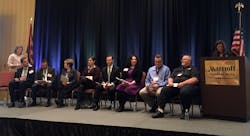The SWTA annual meeting brought together hundreds of transit professionals and vendors from nine states within the region to find ways to better their systems and find best practices to improve efficiency and safety in their communities.
Coming into downtown Mesa down Main Street, you can see a transformation underway.
Getting off the Valley Metro light rail line at the Main and Centennial Way stop, new developments flank the stop with streetscapes opening up the area to wide pedestrian areas for people to stroll past newer shops.
Main looks different than other areas of Mesa with its new light rail line moving people down the corridor while other roads are wide boulevards designed solely for car traffic and only a few winding sidewalks going past them.
Mesa Mayor John Giles said when the light rail line was proposed he was highly skeptical, saying it was just bringing a “Disneyland ride to a ghost town,” in downtown Mesa. But now that it’s open and bumped up the line’s monthly ridership from 90,000 to 180,000 and seeing all the life it brought into the area, he’s glad to admit he was wrong.
Downtown Mesa also saw its first new residential developments in downtown Mesa in 30 years.
“I can’t think of anything else that I’ve been so delighted to be so wrong about,” he said.
Mesa is a standard example of most communities located in the south and west of the U.S., and its change made it a strong host for the 2016 South West Transit Association (SWTA) annual meeting.
The conference brought hundreds of transit professionals and vendors from nine states within SWTA’s region to find ways to improve their systems and find best practices to improve efficiency and safety in their communities.
The conference is themed “Freedom Through Transit,” as transit officials show ways they improve communities and free people from their cars.
Though transit is chided by detractors as stealing freedom, panelist at the opening session said true multimodal systems give freedom because it gives everyone choices on how they move.
Scott Smith, who officially took over as interim CEO of Valley Metro Feb. 1, and is the former mayor of Mesa, said when planning the initial freeways in the valley in the 1980s transit was very politically unpopular in the region, but that sentiment of lost freedom from transit is waning as the argument if fixed guideway rail causes issues because it can’t be moved.
“Last time I checked, when they were planning the freeways they also weren’t planning on moving it either,” he said.
Maria Hyatt, public transit director for the city of Phoenix, said the addition of light rail in the area has been very effective in moving people and building development.
“Light rail is the best running bus system,” she said. “Light rail can move four times the people that our busiest bus routes can.”
And with the success of the initial system, leaders said they’re seeing residents embrace projects including groups that would normally oppose such a project.
About the Author
Joe Petrie
Associate Editor
I came to Mass Transit in 2013 after spending seven years on the daily newsbeat in southeastern Wisconsin.
Based in Milwaukee, I worked as a daily newspaper reporter with the Waukesha Freeman from 2006-2011, where I covered education, county and state government. I went on to cover courts for Patch.com, where I was the main courts reporter in the Metro Milwaukee cluster of websites.
I’ve won multiple awards during the course of my career and have covered some of the biggest political events in the past decade and have appeared on national programs.
Having covered local government and social issues, I discovered the importance of transit and the impact it can have on communities when implemented, supported and funded.

